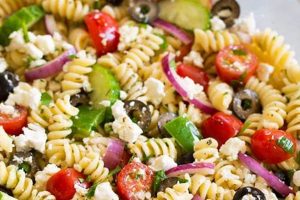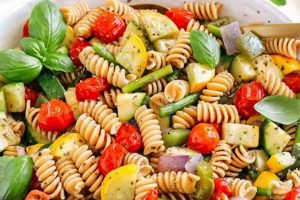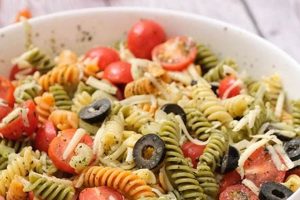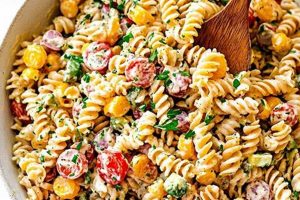A straightforward dish featuring cooked pasta, mayonnaise, and often a variety of supplementary ingredients like vegetables, protein, or herbs, characterizes this type of salad. A classic example might include chilled elbow macaroni tossed with mayonnaise, chopped celery, onion, and hard-boiled eggs, seasoned simply with salt and pepper. Variations can include different pasta shapes, additions like bell peppers, olives, or tuna, and customized seasonings.
This culinary creation offers several advantages. Its ease of preparation, affordability, and adaptability to diverse tastes make it a popular choice for picnics, potlucks, and quick meals. Historically, pasta salads gained traction with the rise of refrigeration and commercially produced mayonnaise in the early 20th century, evolving from simpler pasta dishes. Their inherent versatility allows for creative ingredient combinations, catering to various dietary preferences and seasonal availability.
Further exploration will delve into specific ingredient selections, preparation techniques, variations on the classic formula, and tips for achieving optimal flavor and texture. Nutritional information and suggestions for presentation and serving will also be provided.
Tips for a Superior Pasta Salad
Achieving a well-balanced and flavorful pasta salad depends on careful attention to detail throughout the preparation process. The following tips offer guidance for optimal results.
Tip 1: Cook Pasta Al Dente: Pasta cooked to a firm texture holds its shape better in the salad and prevents a mushy final product. Slightly undercooking is preferable, as the pasta will continue to soften as it absorbs the dressing.
Tip 2: Rinse Cooked Pasta: Rinsing the pasta under cold water stops the cooking process and removes excess starch, preventing the salad from becoming sticky. This also helps the pasta cool quickly, which is essential for maintaining food safety.
Tip 3: Use High-Quality Mayonnaise: The mayonnaise serves as the foundation of the dressing, so selecting a high-quality product significantly impacts the overall flavor. Consider using mayonnaise with added flavors like lemon or herbs for an enhanced taste profile.
Tip 4: Add Flavorful Ingredients: Incorporate a variety of ingredients to create a complex and interesting salad. Consider fresh vegetables, herbs, cheeses, or proteins like grilled chicken or tuna.
Tip 5: Season Appropriately: Seasoning is crucial for a balanced flavor. Salt and pepper are essential, but other seasonings like garlic powder, onion powder, or paprika can enhance the taste. Taste and adjust seasonings as needed.
Tip 6: Chill Thoroughly: Chilling the salad allows the flavors to meld and creates a more refreshing dish. Refrigerate for at least 30 minutes before serving, preferably longer.
Tip 7: Don’t Overdress: Start with a smaller amount of dressing and add more as needed. An overdressed salad can become heavy and soggy.
By following these guidelines, one can elevate a simple pasta salad from basic to exceptional, ensuring a satisfying and enjoyable culinary experience.
These preparatory steps pave the way for a delightful culinary outcome. The following section will offer specific recipe variations and serving suggestions.
1. Pasta Choice
Pasta selection significantly impacts the overall success of a simple pasta salad with mayonnaise. Different pasta shapes offer varying textures and abilities to hold the dressing. Short, sturdy shapes like rotini, fusilli, or farfalle effectively capture the mayonnaise and other ingredients within their curves and ridges, ensuring each bite delivers a balanced flavor profile. Conversely, long, thin pasta like spaghetti or linguine, while suitable for other preparations, tend to become coated unevenly and can clump together in a mayonnaise-based salad. Tubular shapes like penne or macaroni offer a compromise, holding the dressing adequately while maintaining a pleasant texture. The pasta’s ability to absorb and retain the dressing without becoming soggy is paramount.
Consider the specific ingredients when choosing the pasta. For a salad with heavier elements like chunks of chicken or vegetables, a robust pasta shape like rotini provides a sturdy foundation. A lighter salad with finely diced vegetables might benefit from a smaller shape like ditalini. Matching the pasta’s size and shape to the other ingredients ensures a harmonious balance of textures and prevents the salad from feeling disjointed. Overly large pasta can overwhelm delicate ingredients, while overly small pasta can get lost amongst larger components. For example, orzo pasta, with its rice-like shape, pairs well with finely chopped vegetables and herbs, creating a light and refreshing salad. Conversely, a heartier salad with cubed ham and cheese would benefit from the structural integrity of rotini.
Ultimately, successful pasta selection depends on the desired outcome and complementary ingredients. Choosing a pasta shape that effectively holds the dressing, complements the other ingredients, and maintains its texture after chilling contributes significantly to the overall enjoyment of a simple pasta salad with mayonnaise. Ignoring the impact of pasta shape can result in a salad that is either bland due to poor dressing adherence or texturally unappealing due to clumping or sogginess. Careful consideration of these factors ensures a balanced and flavorful result.
2. Mayonnaise Quality
Mayonnaise serves as the foundational element in a simple pasta salad, binding ingredients and contributing significantly to the overall flavor profile. Its quality directly impacts the final dish’s taste, texture, and overall enjoyment. Selecting the right mayonnaise is therefore crucial for achieving a successful and satisfying pasta salad.
- Flavor Profile
Mayonnaise varieties exhibit diverse flavor profiles, ranging from tangy and vibrant to rich and creamy. Some mayonnaises incorporate additional ingredients like lemon juice, herbs, or spices, which impart distinct characteristics. The chosen flavor profile should complement the other ingredients in the salad. For instance, a lemon-infused mayonnaise might pair well with seafood or vegetables, while a classic, creamy mayonnaise might be preferred for a more traditional pasta salad.
- Texture and Consistency
Mayonnaise texture plays a crucial role in the final salad’s consistency. A thick, creamy mayonnaise will coat the pasta evenly and create a rich, decadent mouthfeel. A thinner mayonnaise may result in a runnier salad and a less satisfying texture. The consistency of the mayonnaise should be chosen based on the desired final product. A thicker mayonnaise might be preferred for a salad with heavier ingredients, while a thinner mayonnaise might be suitable for a lighter, more delicate salad.
- Ingredient Quality
The quality of ingredients used in mayonnaise production directly affects its flavor and texture. Mayonnaise made with high-quality oils, eggs, and vinegar will generally have a superior taste and texture compared to mayonnaise made with lower-quality ingredients. Examining the ingredient list can provide insights into the quality of a particular mayonnaise. For example, mayonnaise made with extra virgin olive oil will typically have a more complex flavor profile than mayonnaise made with soybean oil.
- Freshness
Mayonnaise, like all perishable goods, has a limited shelf life. Using fresh mayonnaise ensures optimal flavor and prevents the development of off-flavors or spoilage. Checking the expiration date and storing mayonnaise properly are essential for maintaining its quality. Using expired or improperly stored mayonnaise can negatively impact the flavor and safety of the pasta salad.
The interplay between these factors ultimately determines the mayonnaise’s suitability for a simple pasta salad. Careful consideration of flavor, texture, ingredient quality, and freshness ensures a balanced and enjoyable final product. A high-quality mayonnaise elevates the overall experience, transforming a simple pasta salad from ordinary to exceptional.
3. Ingredient Pairings
Ingredient pairings significantly influence the overall flavor profile and textural complexity of a simple pasta salad with mayonnaise. Careful consideration of complementary flavors and textures elevates this dish from basic to exceptional. A harmonious balance of ingredients creates a more satisfying and enjoyable culinary experience.
- Complementary Flavors
Flavor pairings form the foundation of a successful pasta salad. The mayonnaise base provides a creamy, tangy backdrop, allowing for a wide range of flavor combinations. Classic pairings include savory elements like celery, onion, and hard-boiled eggs, which provide a familiar and comforting taste. Brighter flavors like bell peppers, olives, or fresh herbs add depth and complexity. Acidic ingredients like pickles or vinegar balance the richness of the mayonnaise. The goal is to create a balanced flavor profile that is neither bland nor overwhelming.
- Textural Variety
Textural contrast enhances the eating experience. The soft pasta and creamy mayonnaise benefit from the addition of crisp vegetables like cucumbers, carrots, or celery. Chewy ingredients like sun-dried tomatoes or artichoke hearts add another layer of interest. Protein additions like grilled chicken, shrimp, or chickpeas provide a satisfying heartiness. The interplay of textures creates a more dynamic and engaging culinary experience.
- Color Considerations
Visual appeal contributes to the overall enjoyment of food. A vibrant and colorful pasta salad is more appetizing than a monotone one. Incorporating a variety of colorful vegetables, like red bell peppers, green peas, or orange carrots, enhances the visual appeal. Fresh herbs like parsley or dill add a touch of brightness. Thoughtful color combinations create a visually stimulating and appealing dish.
- Seasonal Adaptations
Seasonal ingredients offer peak flavor and freshness. Utilizing in-season produce enhances the taste and nutritional value of the pasta salad. Spring vegetables like asparagus or peas create a light and refreshing salad. Summer tomatoes and corn offer a burst of sweetness. Fall vegetables like roasted squash or Brussels sprouts provide a heartier option. Adapting the ingredients to the season ensures optimal flavor and allows for creative variations.
The interplay of these factors contributes to the creation of a well-balanced and flavorful simple pasta salad with mayonnaise. Thoughtful ingredient selection elevates this seemingly simple dish, showcasing the potential for complexity and culinary creativity within its framework. By understanding the principles of flavor pairings, textural variety, color considerations, and seasonal adaptations, one can consistently create a delicious and satisfying pasta salad experience.
4. Seasoning Balance
Seasoning balance is paramount in a simple pasta salad recipe with mayonnaise. Mayonnaise, while providing a creamy texture and tangy flavor, can also mute other ingredients if not properly balanced. Careful seasoning elevates the dish, preventing blandness and allowing the individual components to shine. The interplay of salt, pepper, and other seasonings enhances the overall flavor profile, creating a more complex and satisfying culinary experience. An under-seasoned pasta salad tastes flat and uninspired, while an over-seasoned salad can be overwhelming and mask the subtle flavors of the other ingredients.
Consider a classic pasta salad with celery, onion, and hard-boiled eggs. Salt enhances the natural sweetness of the celery and onion, while pepper adds a subtle bite. A touch of garlic powder or onion powder can further amplify the savory notes. For a pasta salad with Mediterranean flavors, herbs like oregano, basil, or dill complement the mayonnaise and vegetables. A squeeze of lemon juice adds brightness and acidity. A pasta salad with a Southwestern flair might benefit from the addition of chili powder, cumin, or smoked paprika. The key is to taste and adjust seasonings throughout the process, ensuring a harmonious blend of flavors.
Achieving seasoning balance requires an understanding of the interplay between ingredients and seasonings. The inherent flavors of the vegetables, proteins, and herbs influence the choice and quantity of seasonings. Fresh herbs often require less seasoning than dried herbs, as their flavor is more pronounced. The saltiness of ingredients like olives or capers should be considered when adding salt. Ultimately, achieving seasoning balance is a matter of taste and experimentation. Starting with small amounts of seasoning and gradually increasing until the desired flavor is achieved is a prudent approach. Proper seasoning elevates a simple pasta salad with mayonnaise from ordinary to extraordinary, transforming it into a dish that is both flavorful and satisfying.
5. Chilling Time
Chilling time represents a crucial step in preparing a simple pasta salad with mayonnaise. It significantly influences the final dish’s flavor development, texture, and food safety. Sufficient chilling allows the flavors of the various ingredients to meld, creating a more cohesive and balanced flavor profile. Understanding the importance of chilling time and its impact on the final product is essential for achieving optimal results.
- Flavor Enhancement
Chilling allows the flavors of the individual ingredients, including the mayonnaise, vegetables, and seasonings, to permeate the pasta and each other. This melding of flavors creates a more complex and nuanced taste profile compared to a freshly made, unchilled salad. The chilling process allows the subtle nuances of each ingredient to emerge, resulting in a more harmonious and balanced overall flavor. For example, the sharpness of onions mellows, and the herbs release their aromatic oils, enhancing the overall taste experience.
- Texture Improvement
Chilling firms the pasta and allows it to absorb the mayonnaise and other dressing ingredients more effectively. This results in a more cohesive texture, preventing the salad from becoming soggy or watery. The chilled temperature also enhances the crispness of vegetables like celery and bell peppers, contributing to a more satisfying textural contrast. Without sufficient chilling, the pasta may remain too soft, and the vegetables may lose their desired crispness, resulting in a less appealing texture.
- Food Safety
Mayonnaise-based salads are susceptible to bacterial growth if left at room temperature for extended periods. Chilling inhibits bacterial growth, ensuring food safety and preventing spoilage. Maintaining a safe temperature below 40F (4C) is crucial for preventing foodborne illnesses. Adhering to proper chilling guidelines protects against potential health risks associated with consuming contaminated food.
- Optimal Serving Temperature
A chilled pasta salad is more refreshing and palatable, especially in warmer weather. The cool temperature enhances the flavors and textures, providing a more enjoyable eating experience. Serving a pasta salad at the optimal temperature maximizes its appeal and contributes to a more satisfying meal. A warm pasta salad can taste heavy and unappetizing, diminishing the overall culinary experience.
Therefore, adequate chilling time is not merely a suggestion but a critical component in creating a successful simple pasta salad recipe with mayonnaise. It plays a vital role in flavor development, texture enhancement, and food safety, ultimately contributing to a more enjoyable and satisfying culinary experience. Neglecting this crucial step can compromise the overall quality and safety of the dish.
Frequently Asked Questions
This section addresses common inquiries regarding the preparation and enjoyment of pasta salad featuring mayonnaise.
Question 1: What is the best pasta shape for pasta salad?
Sturdy, short pasta shapes like rotini, farfalle, or fusilli hold dressing well and prevent clumping. Longer shapes can become unwieldy and coated unevenly.
Question 2: Can low-fat mayonnaise be used?
While permissible, low-fat mayonnaise may result in a thinner dressing and slightly altered flavor profile. Full-fat mayonnaise provides a richer, creamier texture.
Question 3: How long can pasta salad be stored?
Refrigerated storage in an airtight container is recommended for up to 3-5 days. Discard any salad exhibiting signs of spoilage, such as an off odor or discoloration.
Question 4: Can pasta salad be frozen?
Freezing is not recommended. Mayonnaise-based dressings separate and become watery upon thawing, resulting in an undesirable texture.
Question 5: How can one prevent pasta salad from becoming watery?
Ensure pasta is cooked al dente and cooled completely before combining with other ingredients. Avoid overdressing the salad, as excess moisture can contribute to wateriness.
Question 6: What are common allergens to consider when preparing pasta salad?
Common allergens include gluten (from wheat-based pasta), eggs (in mayonnaise), and dairy (if cheese is added). Ingredient lists should be carefully reviewed to accommodate dietary restrictions.
Addressing these frequently asked questions provides a foundation for successful pasta salad preparation. Attention to detail, from ingredient selection to storage practices, ensures a satisfying culinary outcome.
The following section offers variations on this classic dish, expanding culinary possibilities.
Simple Pasta Salad Recipe with Mayo
Exploration of this straightforward dish reveals its versatility and enduring appeal. Careful ingredient selection, including pasta shape and mayonnaise quality, significantly impacts the final product. Achieving a balance of flavors, textures, and colors elevates the dish beyond basic fare. Proper seasoning and chilling are crucial for both flavor development and food safety. Understanding these elements allows for creative variations and consistent, enjoyable results.
This seemingly simple dish offers a canvas for culinary expression. Adaptability to diverse ingredients and flavor profiles ensures its continued presence in kitchens and at gatherings for years to come. Continued experimentation with ingredients and techniques promises further evolution and enjoyment of this culinary staple.






